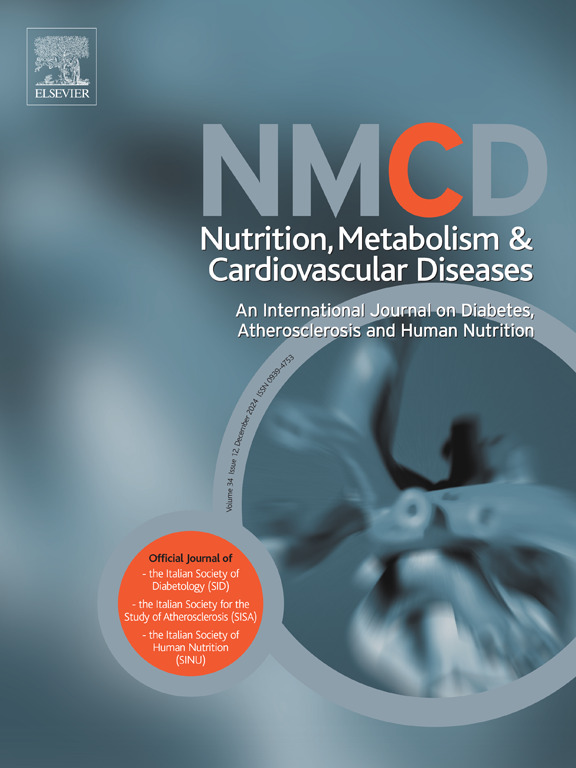Serum uric acid and mortality in metabolic dysfunction-associated steatotic liver disease: Subgroup differences
IF 3.3
3区 医学
Q2 CARDIAC & CARDIOVASCULAR SYSTEMS
Nutrition Metabolism and Cardiovascular Diseases
Pub Date : 2024-09-21
DOI:10.1016/j.numecd.2024.09.015
引用次数: 0
Abstract
Background and aims
This study aims to investigate the association between serum uric acid (SUA) and both the risk and long-term mortality of dysfunction-associated steatotic liver disease (MASLD), and to explore differences between the pure MASLD and metabolic and alcohol related/associated liver disease (MetALD) subgroups.
Methods and results
We included 11,675 participants from the Third National Health and Nutrition Examination Survey, with matched mortality data up to 2019. Logistic regression and Cox proportional hazards regression evaluated the relationship between SUA and both the risk and mortality of MASLD. Non-linear correlations and threshold effects were explored using restricted cubic splines and a two-piecewise Cox proportional hazards model. We found that SUA was positively associated with the risk of MASLD [odds ratio (OR): 1.19, 95 % confidence interval (CI) 1.12–1.27]. For pure MASLD, SUA showed a positive association with all-cause mortality [<4.7 mg/dL: hazard ratio (HR): 1.34, 95 % CI 1.04–1.73; ≥4.7 mg/dL: HR: 1.08, 95 % CI 1.02–1.15] and cardiovascular mortality (HR: 1.12, 95 % CI 1.02–1.22). For MetALD, there was an inverse J-shaped relationship (threshold: 6.6 mg/dL) between SUA and all-cause mortality. Below the threshold, SUA was negatively correlated with all-cause mortality (HR: 0.42, 95 % CI 0.19–0.93), but no association was found above it (HR: 0.81, 95 % CI 0.54–1.21). Additionally, no association was observed between SUA and cardiovascular mortality.
Conclusions
SUA serves as an independent predictor of the risk and all-cause mortality of MASLD. The relationship between SUA and both all-cause and cardiovascular mortality differs between the pure MASLD and MetALD subgroups.
代谢功能障碍相关脂肪性肝病患者的血清尿酸与死亡率:亚组差异。
背景和目的:本研究旨在调查血清尿酸(SUA)与功能障碍相关性脂肪性肝病(MASLD)的风险和长期死亡率之间的关系,并探讨纯MASLD亚组与代谢和酒精相关/相关性肝病(MetALD)亚组之间的差异:我们纳入了来自第三次全国健康与营养调查的 11,675 名参与者,并提供了截至 2019 年的匹配死亡率数据。逻辑回归和 Cox 比例危险度回归评估了 SUA 与 MASLD 风险和死亡率之间的关系。我们使用限制性三次样条和双片式 Cox 比例危险模型探讨了非线性相关性和阈值效应。我们发现,SUA 与罹患 MASLD 的风险呈正相关[比值比 (OR):1.19,95% 置信区间 (CI) 1.12-1.27]。对于纯 MASLD,SUA 与全因死亡率呈正相关[结论:SUA是MASLD风险和全因死亡率的独立预测因子。SUA与全因死亡率和心血管死亡率之间的关系在纯MASLD亚组和MetALD亚组之间有所不同。
本文章由计算机程序翻译,如有差异,请以英文原文为准。
求助全文
约1分钟内获得全文
求助全文
来源期刊
CiteScore
6.80
自引率
2.60%
发文量
332
审稿时长
57 days
期刊介绍:
Nutrition, Metabolism & Cardiovascular Diseases is a forum designed to focus on the powerful interplay between nutritional and metabolic alterations, and cardiovascular disorders. It aims to be a highly qualified tool to help refine strategies against the nutrition-related epidemics of metabolic and cardiovascular diseases. By presenting original clinical and experimental findings, it introduces readers and authors into a rapidly developing area of clinical and preventive medicine, including also vascular biology. Of particular concern are the origins, the mechanisms and the means to prevent and control diabetes, atherosclerosis, hypertension, and other nutrition-related diseases.

 求助内容:
求助内容: 应助结果提醒方式:
应助结果提醒方式:


